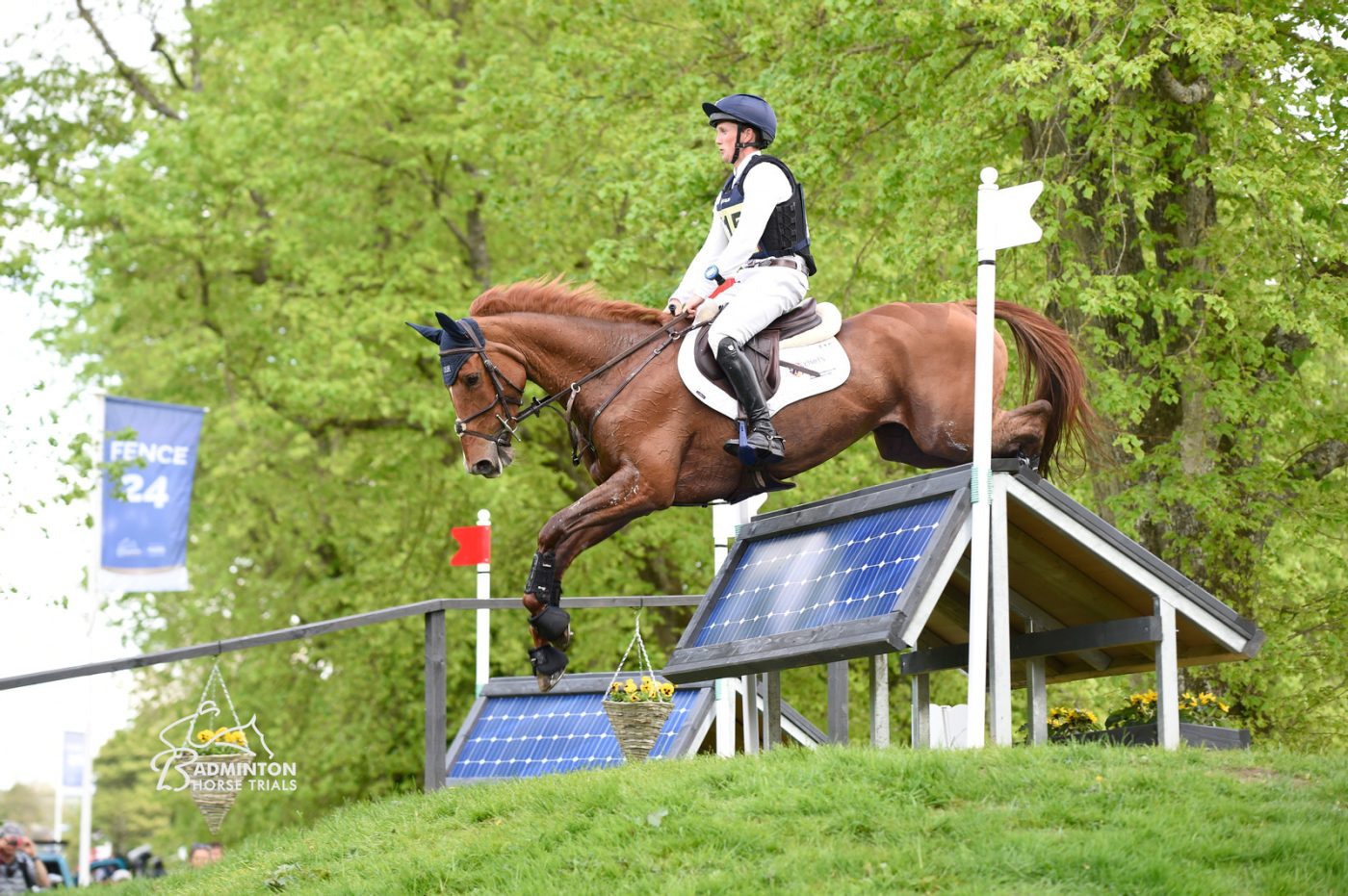Eventing Explained
The Competition
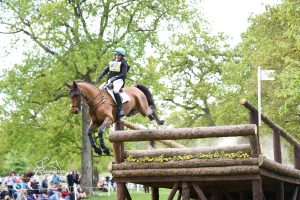
Badminton Horse Trials is one of the toughest and most exciting equestrian events – the pinnacle of the worldwide horse trials calendar. Horses and riders complete the competition over 4 days, each day consisting of a different discipline. Horses and riders must first complete a dressage test on day 1 or 2 (the dressage is spread over two days in order to be able to accommodate all the entries), demonstrating Obedience, Discipline, Accuracy and Elegance. On day 3 they need to prove their fitness, athleticism and stamina by tackling a 4 mile cross country course jumping solid man-made and natural obstacles within a set time. Finally, on day 4, the competitors must complete a course of show jumps designed to test their agility and accuracy, again within a given time, to demonstrate soundness and the ability to recover.
The order of starting is the same for the dressage and cross country test and will be fixed by draw. On the last day competitors will be required to jump in reverse order of the placings after the cross country phase.
Competition Level
International horse trials are given a star grading according to their level of difficulty. The higher the grade, or number of stars, the more complex and physically demanding the competition becomes. Badminton is a 5 star event, the highest grade and one of only 7 such events in the world. Badminton is the oldest (1949) and is generally regarded as the most prestigious event.
Both horses and riders must qualify in order to compete at Badminton. Qualification can take a number of years to achieve.
Horse Inspection
Wednesday 7th May
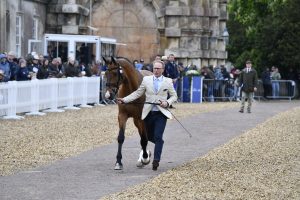
Aaron Millar riding KEC Deakon for (GBR)
Before the competition starts each horse is ‘trotted up’ in front of an inspection panel consisting of a vet and the Ground Jury (judges) to ensure the horse is healthy, sound and fit to compete. This is called the First Inspection and takes place on the Wednesday afternoon.
Phase One: Dressage
Thursday 8th May & Friday 9th May
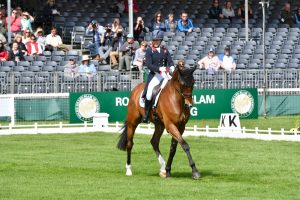
Dressage is the first phase of the competition. Horse and rider must complete a ‘test’ of set movements between markers in a 20m by 60m arena. At regular intervals points are marked with letters so the riders and judges know where each movement is to be performed.
Badminton’s dressage test consists of 25 movements in walk, trot and canter and of varying complexity. Each test takes approx. 7 ½ minutes to complete.
The test is assessed by three judges (the Ground Jury) who each sit at different points of the arena. Each movement carries a maximum of 10 marks, with an additional mark out of 20 for overall impression.
The score for the three judges is then averaged and expressed in two ways, as a percentage (good marks), which enables spectators to see how well each competitor has performed; and as a penalty score (points lost). The penalty score is simply the difference between the percentage mark and 100, e.g. 65% gives 35 penalties. The lower the penalty score, the better, as this is carried forward to the following day.
With between 75 and 85 riders competing, some riding two horses, the Dressage phase is held over two days (Thursday and Friday).
Phase Two: Cross Country Test
Saturday 10th May
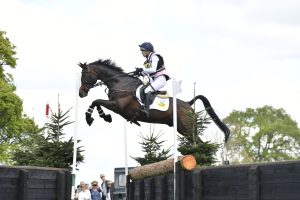
The cross country test is the most physically demanding and exciting phase of the competition. There are about 45 ‘jumping efforts’ on the course; obstacles can consist of a single fence or a combination of a number of different fences, e.g. 15A, B and C. The course must be completed at an average speed of 570 metres per minute; this speed, calculated with the length of the course gives the ‘optimum time’. This time is deliberately difficult to achieve and penalty marks are added at the rate of 0.4 for every second exceeding the optimum. A time limit of double the optimum time is also imposed – exceeding this time limit leads to elimination.
Penalty points for errors on the course are designed to have the greatest influence of the three phases on the overall competition.
| Faults/Errors | Penalty |
|---|---|
| First refusal, run-out or circle | 20 points |
| Second refusal, run out or circle at the same obstacle | 40 points |
| Third refusal, run out or circle on Cross Country Course | Elimination |
| Fall of Athlete or Horse on the Cross Country Course | Elimination |
| Activating a frangible device where the dimension of the fence is modified | 11 penalties |
| Dangerous Riding | 25 penalties |
| Missing a flag (as per FEI rules) | 15 penalties |
The penalty marks accumulated for the cross country test are added to the dressage penalty marks and carried forward to the jumping test on the final day.
The Final Horse Inspection
Sunday 11th May
A further inspection of the horses takes place on the Sunday morning prior to the Jumping test. This ‘trot-up’ ensures the horses are still sound and fit enough to compete on the final day and complete the competition.
Phase Three: Jumping Test
Sunday 11th May
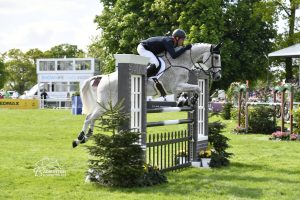
After the physical demands of cross country day, horses and riders must then demonstrate accuracy and agility in the jumping test by completing a course of show jumps up to 1.30m high and 2.30m wide. This requires both horse and rider to be extremely fit and calm. Penalties are picked up by knocking down the deliberately balanced fences, refusing to jump a fence or not completing the course within the optimum time. The competitors jump in reverse order, so the leader after the cross country is the last to jump, giving a nail-biting finish to the event. Many events are won or lost on this final day when the pressure is on in front of the 13,000 spectators filling the arena.
Faults
| Faults/Errors | Penalty |
|---|---|
| 1st Refusal/disobedience | 4 points |
| 2nd Refusal/disobedience | Elimination |
| Knocking down an obstacle | 4 points |
| Fall of Horse and/or rider | Elimination |
| Time Faults | 0.4 per second over the time allowed |
Any penalties from the jumping test are added to give the final results of the competition. The horse and rider with the lowest final score is declared the winner.
Results Example
| No. | Horse | Rider | Dressage | Cross Country | Show Jump | Total | Diff. | Place | |||||
|---|---|---|---|---|---|---|---|---|---|---|---|---|---|
| Pens. | Place | Jump | Time | Pens | Place | Jump | Time | Pens | |||||
| 32 | Vanir Kamira | Piggy French | 26.0 | (4) | – | 0.8 | 26.8 | (2) | – | – | 26.8 | – | 1 |
| 97 | Ballaghmor Class | Oliver Townend | 21.1 | (2) | – | 0.4 | 21.5 | (1) | 4 | 1.6 | 27.1 | 0.3 | 2 |
